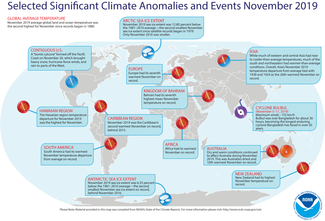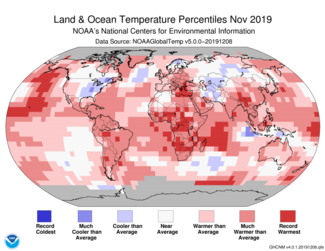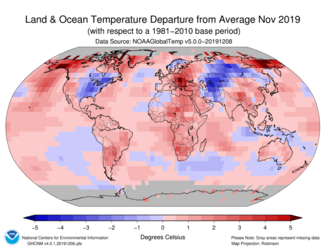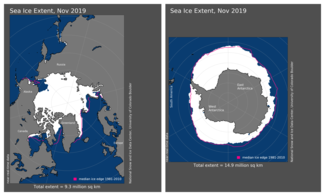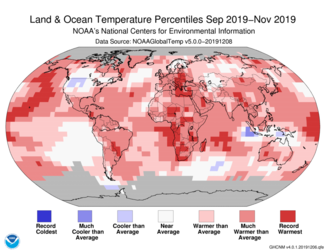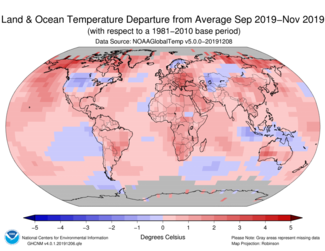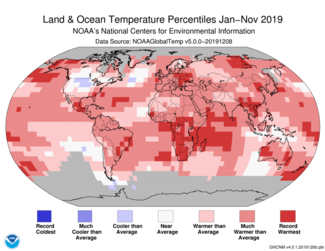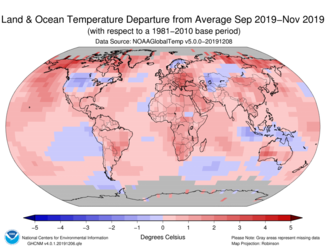Globe had the second warmest November on record

The global land and ocean surface temperature departure from average for November 2019 was the second highest for the month of November in the 140-year NOAA global temperature dataset record. The September–November 2019 and January–November 2019 temperatures were also the second highest such periods on record.
This monthly summary, developed by scientists at NOAA’s National Centers for Environmental Information, is part of the suite of climate services NOAA provides to government, business, academia, and the public to support informed decision-making.
November Temperature
-
The November temperature across global land and ocean surfaces was 1.66°F (0.92°C) above the 20th-century average of 55.2°F (12.9°C) and was the second highest for November in the 1880–2019 record. Only November 2015 was warmer. The five warmest Novembers have all occurred since 2013.
- November 2019 marked the 43rd consecutive November and the 419th consecutive month with temperatures, at least nominally, above the 20th century average.
- November 2019 was characterized by warmer-than-average conditions across much of the global land and ocean surfaces. Record-warm November temperature departures from average were present across parts of the North and Western Pacific Ocean, Africa, southern Asia, South America, the Atlantic Ocean, the Mediterranean Sea, and northwestern Indian Ocean. Cooler-than-average conditions were present across the eastern half of the contiguous U.S. and southeastern Canada and northern parts of the Atlantic Ocean, as well as across parts of northern and southwestern Asia. However, no land or ocean areas had record-cold November temperatures.
- Regionally, South America, Africa, and the Hawaiian region had record-warm November temperatures. The Caribbean region had its second warmest November on record, trailing behind November 2015. Europe had its seventh warmest November on record.
-
The November globally averaged land surface temperature was 2.34°F (1.30°C) above the 20th century average of 42.6°F (5.9°C). This was the eighth highest November land temperature in the 140-year record.
-
The November globally averaged sea surface temperature was 1.39°F (0.77°C) above the 20th-century monthly average of 60.4°F (15.8°C), also the second highest global ocean temperature for November on record, behind November 2015.
Sea Ice and Snow Cover
-
The Arctic sea ice extent for November 2019 was the second smallest on record at 530,000 square miles, or 12.80%, below the 1981–2010 average, according to an analysis by the National Snow and Ice Data Center (NSIDC) using data from NOAA and NASA. November 2016 had the lowest sea ice extent for the month at 790,000 square miles, or 19.1 percent, below the 1981–2010 average. The 10 smallest Arctic November sea ice extents have occurred since 2007. According to NSIDC, Chukchi Sea, Hudson Bay, and Davis Strait had well-below-average sea ice extent for the month.
-
The Antarctic sea ice extent for November 2019 was 390,000 square miles, or 6.35%, below the 1981–2010 average. This was also the second smallest sea ice extent for November in the 41-year record, trailing behind the record-low November sea ice extent of 2016 (10.6 percent below average).
-
According to data from NOAA and analyzed by the Rutgers Global Snow Lab, the Northern Hemisphere snow cover extent during November was 1.20 million square miles above the 1981–2010 average and the fifth highest November snow cover extent in the 54-year record. The North American and Eurasian snow cover extents were also above average, ranking as the third and 14th largest snow cover extent, respectively.
Seasonal (September–November 2019)
-
The September–November 2019 average temperature across global land and ocean surfaces was 1.69°F (0.94°C) above the 20th-century average of 57.1°F (14.0°C) and the second highest for September–November in the 1880–2019 record. September–November 2015 was the warmest such period on record at 1.80°F (1.00°C) above average. The five warmest September–November periods have occurred in the last five years (2015–2019).
- The Northern Hemisphere September–November 2019 land and ocean surface temperature was also the second warmest such period in the 140-year record at 2.11°F (1.17°C) above average. This is only 0.07°F (0.04°C) cooler than the record-warm September–November set in 2015.
- The Southern Hemisphere September–November 2019 land and ocean surface temperature tied with 2018 as the second highest September–November temperature since global records began in 1880, with a hemispheric land and ocean surface temperature average of 1.26°F (0.70°C) above average. Only September–November 2015 was warmer.
- Warmer-than-average conditions were present across much of the globe during the three-month season. Record-warm temperatures during September–November 2019 were present across parts of the North and Western Pacific Ocean, Europe and the Mediterranean Sea, Africa, western tropical Indian Ocean, the Atlantic Ocean, and Asia. Cooler-than-average conditions were present across parts of the north-central contiguous U.S., the north Atlantic Ocean, and the southern oceans. However, no land or ocean areas had a record-cold September–November 2019 temperature.
-
The globally averaged land surface temperature for September–November was the second highest on record at 2.45°F (1.36°C) above the 20th-century average of 48.3°F (9.1°C). This value trails behind the record-warm September–November of 2015.
- Regionally, South America, Europe, Africa, and the Hawaiian region had a September–November temperature departure from average that ranked among the three warmest such periods on record. Of note, South America and the Hawaiian region had their warmest September–November on record.
-
The September–November globally averaged sea surface temperature of 1.40°F (0.78°C) above the 20th-century average of 60.7°F (16.0°C) was the second warmest such period on record, behind 2015. The five warmest global sea surface temperatures for September–November have occurred since 2015.
Year-to-date (January–November 2019)
-
The year-to-date temperature across global land and ocean surfaces was 1.69°F (0.94°C) above the 20th-century average of 57.2°F (14.0°C) — the second highest for January–November in the 140-year record, trailing behind 2016 (+1.82°F / +1.01°C).
- Record-warm temperatures during the year-to-date period were present across parts of North America, South America, Europe, the southern half of Africa, northern and southern Asia, Australia, and New Zealand. Across the oceans, record-warm year-to-date temperatures were present across parts of northern and southwestern Pacific Ocean, the Atlantic Ocean, and the western Indian Ocean. No land or ocean areas had record-cold temperatures during January–November 2019.
-
The year-to-date globally averaged land surface temperature was 2.50°F (1.39°C) above the 20th-century average of 48.1°F (9.0°C). This value was the third highest for January–November on record—only 2016 and 2017 were warmer.
- Regionally, South America, Europe, Africa, Asia, Oceania, the Gulf of Mexico, and the Hawaiian region had a January–November 2019 temperature departure from average that ranked among the three highest such periods on record.
-
The year-to-date globally averaged sea surface temperature was 1.39°F (0.77°C) above the 20th-century average of 61.0°F (16.1°C). This was also the second highest for January–November in the 1880–2019 record, trailing behind 2016 by 0.05°F (0.03°C).
For a more complete summary of climate conditions and events, see our November 2019 Global Climate Report.

